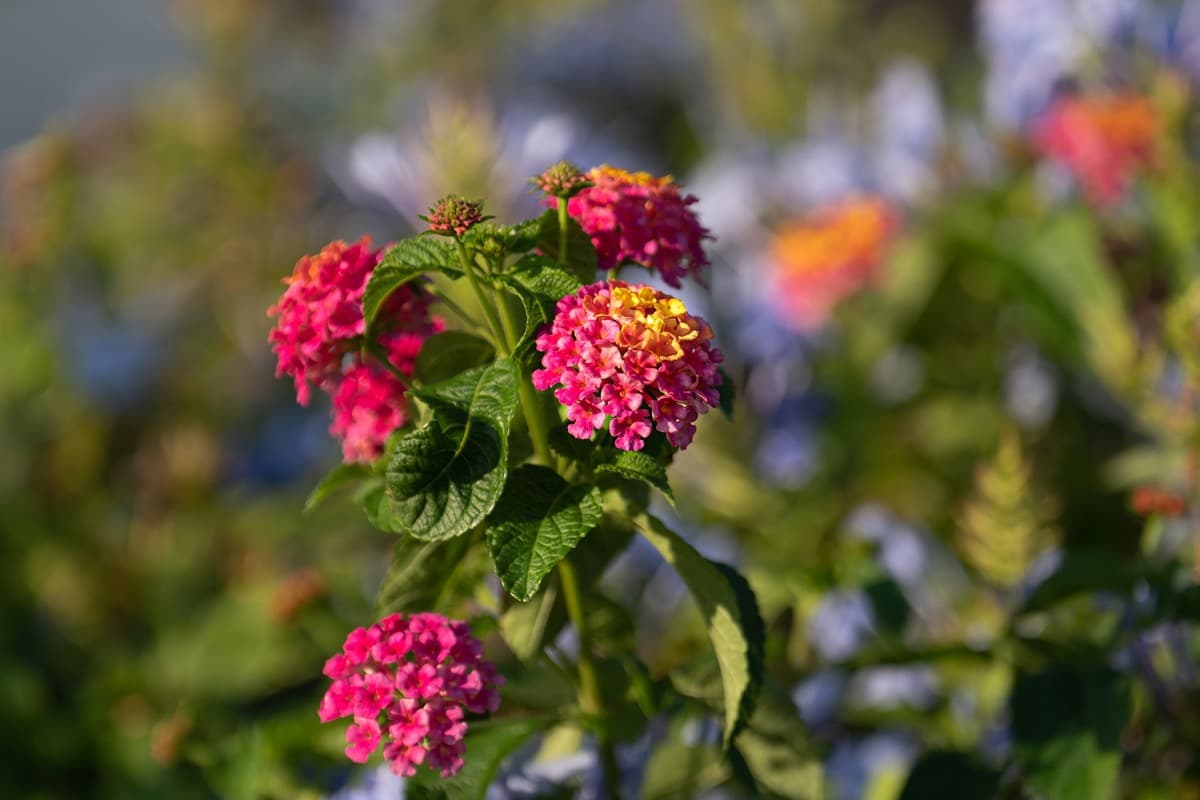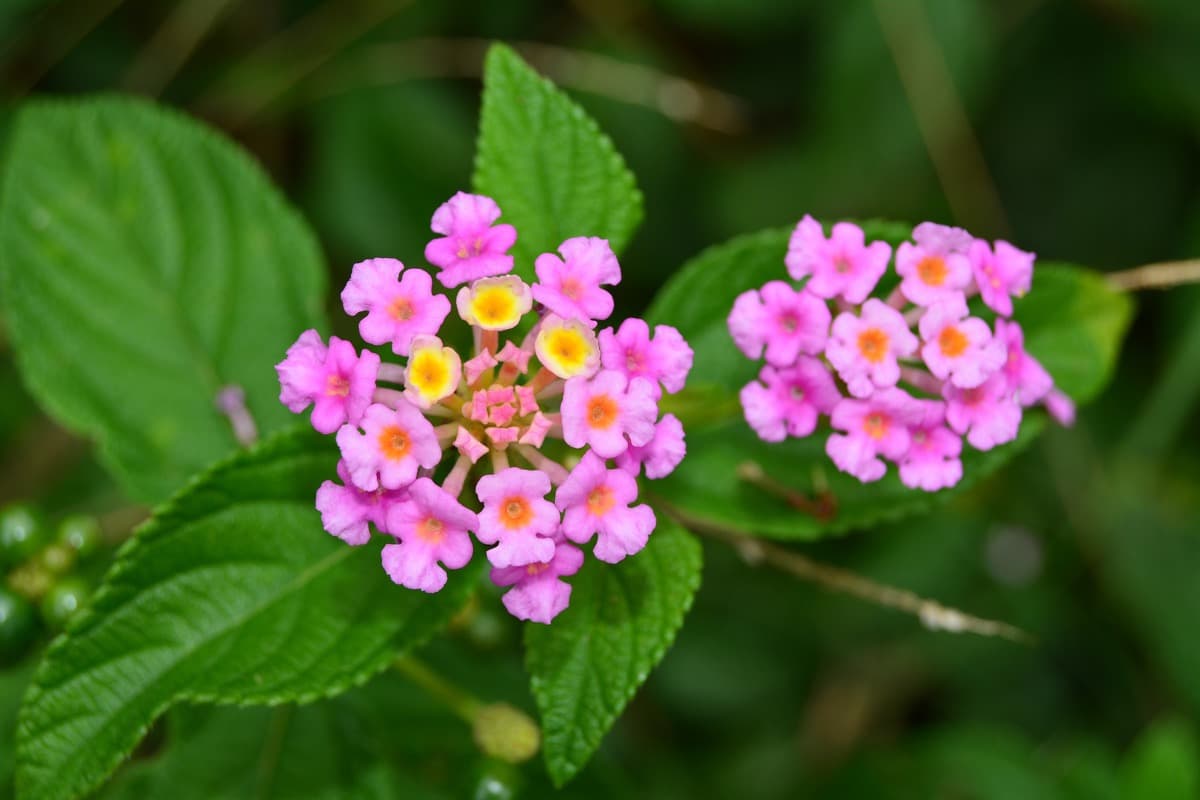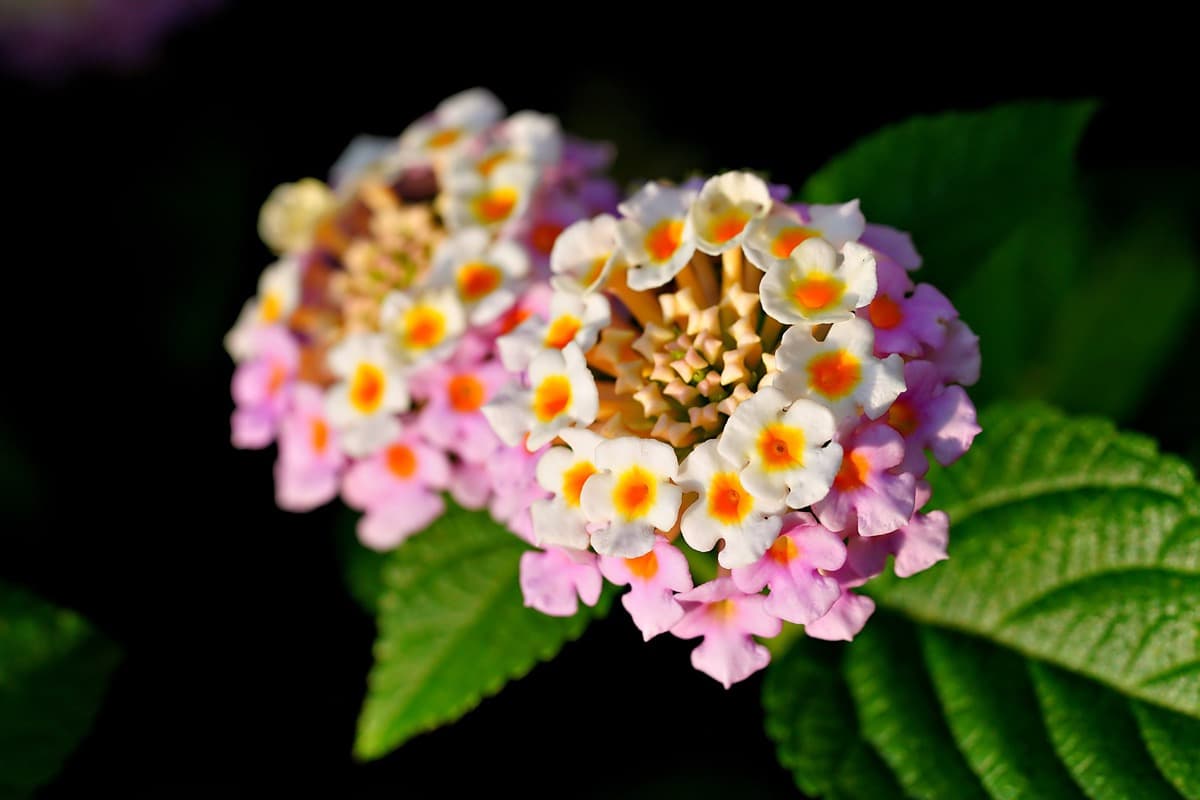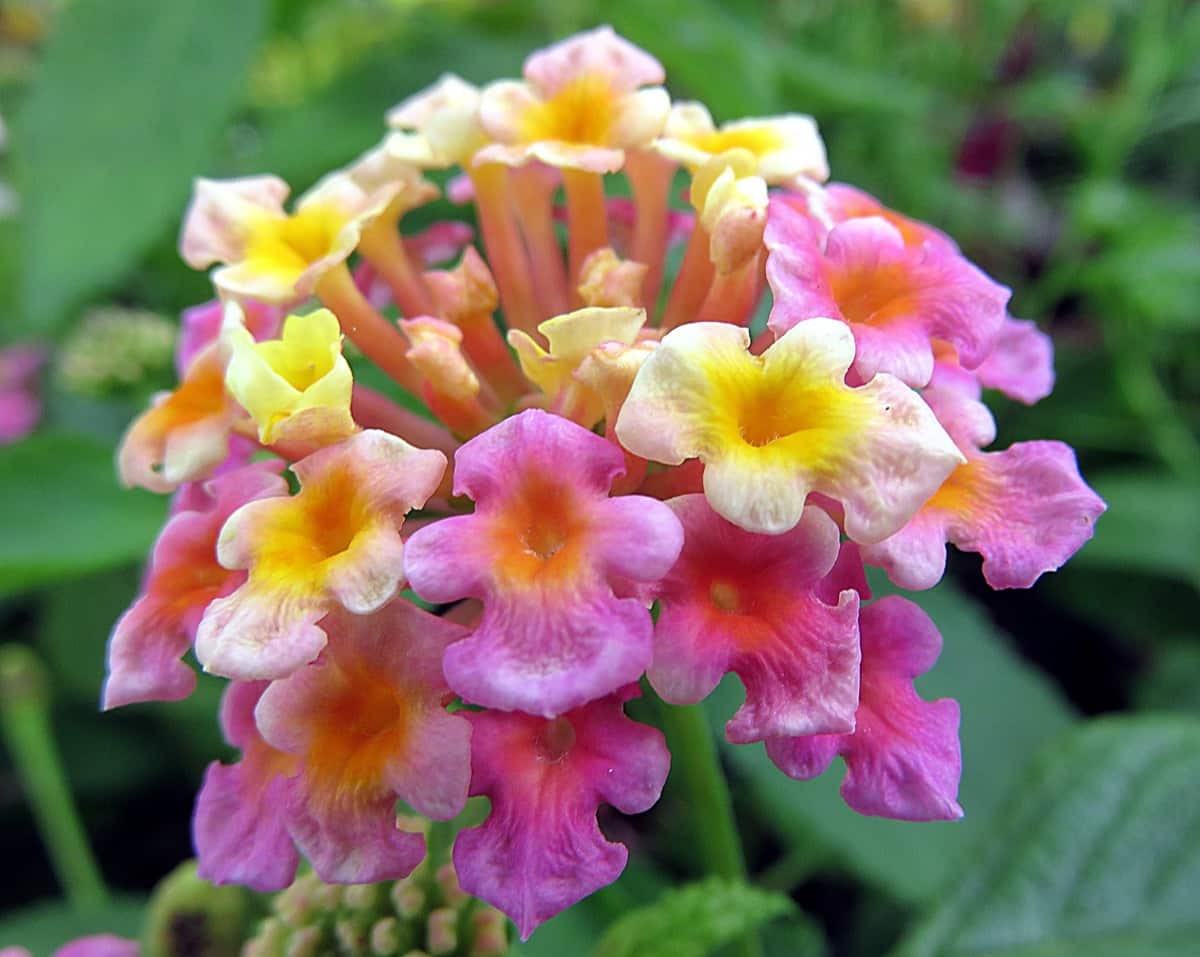Lantana is a beautiful tropical plant that can add a touch of beauty to any garden. Lantana can be grown as an annual or a perennial, depending on your climate. If you live in an area where it gets cold in the winter, Lantana will need to be brought indoors or grown as an annual. Lantana comes in various colors, including yellow, orange, pink, and red. The flowers are borne in clusters and bloom throughout the summer. The leaves are dark green and somewhat shiny. Lantana is a fast-growing plant and can quickly become overgrown if not pruned regularly.

How to grow and care for Lantana in your garden
Types of Lantana
- Lantana montevidensis – It is a perennial herbaceous plant growing to 1–2 meters tall. The leaves are opposite, ovate-lanceolate, 6–12 centimeters long and 3–6 centimeters broad, with a serrated margin. The flowers are borne in clusters of 3-15 at the ends of the stems; each flower is 5–6 cm in diameter, with five petals fused at the base to form a tube. Lantana montevidensis is grown as an ornamental plant in gardens.
- Lantana trifolia – It is a perennial plant that grows to be about 3 feet tall and wide. The leaves are ovate-shaped and have a serrated margin. The flowers are white with purple or yellow centers and bloom from summer to fall.
- Miss Huff – Lantana plants come in many different colors and varieties. Miss Huff is a popular variety that features pink and purple flowers. These beautiful plants are easy to care for and add to any landscape.
- Bandito – There are many different Lantana plants, but the Bandito variety is one of the most popular. This plant is known for its beautiful, bright flowers that bloom throughout the summer. The Bandito Lantana is the best choice for gardeners who wish to add a splash of color to their yard or patio.
Climate suitable for growing Lantana
Lantana is a tropical to sub-tropical plant that thrives in hot, humid conditions. You can use it as an ornamental plant in gardens, and it can be found in various colors, including pink, orange, yellow, and red. While Lantana is tolerant of dry conditions, it prefers a climate with high humidity and plenty of rainfall.
In case you missed it: How to Grow and Care for Rubber Plants Indoors: A Beginners Guide

It can tolerate some shade but does best in full sun. The soil should be well-drained and fertile, and Lantana does not like to be waterlogged. If you live in a suitable climate for growing Lantana, you can direct sow the seeds or start them indoors about 6-8 weeks before the last frost date.
Soil requirement for growing Lantana
Lantana requires soil with good drainage to thrive. Amend heavy clay soils with organic matter such as compost to improve drainage. Lantana will grow in poor soils, but adding organic matter will help it to be more vigorous and produce more flowers. Lantana does not tolerate wet feet, so make sure the planting bed is well-drained.
Lantana is a tough, heat-loving plant that does not require much in the way of soil preparation. It will grow in almost any type of soil as long as it is well-drained. Amend heavy clay soils with organic matter to improve drainage. Many soil types exist, but Lantana does best in sandy, well-drained soils.
If your soil is heavy and clay-like, you should consider mixing in some sand to improve drainage. Lantana prefers neutral to slightly acidic soils with a pH between 6.0 and 7.0. If you’re unsure what type of soil you have, it’s always best to err on the side of too much drainage rather than too little. Lantana is a very drought-tolerant plant that can handle dry conditions better than wet feet.
Water requirement for growing Lantana
Lantana is a tough plant that can tolerate long periods of drought, but it will produce more flowers if given ample water. During the active growth period, water Lantana deeply and regularly to keep the soil moist but not soggy. Based on your climate, you may need to water Lantana once or twice a week. Reduce watering in fall and winter when the plant is dormant.
In case you missed it: How to Grow and Care for Verbena in the Garden: A Beginners Guide

Lantana is a sun-loving plant and will thrive in hot, dry conditions. It is not particular about soil type, but it does need well-drained soil. Once established, Lantana is very drought tolerant. Water regularly during the growing season to establish a deep, extensive root system. After that, water only when the soil is dry to the touch. Too much water will cause the roots to rot.
Propagating Lantana
From stem cuttings
Lantana is a tropical to sub-tropical plant that can be grown as an annual in cooler climates. It is a fast-growing, heat-loving plant that blooms all summer long with little care. Lantana is available in many colors, including yellow, orange, pink, red, and purple. The flowers are borne in clusters and attract bees and butterflies.
To propagate Lantana, take stem cuttings in late spring or early summer. You can take cuttings 4-6 inches long from new growth. Remove the bottom leaves of the cutting and dip the cutting in the rooting hormone. Plant the cutting in a moist potting mix and keep it warm. The cutting should root within 2-3 weeks. Once rooted, transplant the Lantana into a larger pot or garden.
From seeds
If you want to propagate Lantana from seeds, starting them indoors about 6 to 8 weeks before your last frost date is best. Sow the Lantana seeds on the surface of a moist, well-drained seed-starting mix and press them lightly into the mix. Water the seeds gently and keep the soil moist but not soggy. The seeds should germinate in 10-14 days. Once they are large enough to handle, harden them off for a week or two before planting them out in your garden after all danger of frost has passed. Space the plants 18-24 inches apart.
In case you missed it: How to Grow and Care for Polka Dot Plants in Pots: A Beginners Guide

Transplanting Lantana seedlings
Lantana is a heat-loving plant, so choose a spot in your garden that gets plenty of sunlight. Lantana is drought tolerant once established but will produce more flowers if given regular water. You’ll also need to prepare the planting hole by loosening the soil and adding some compost. When ready to plant, gently remove each seedling from its pot and place it in the prepared planting hole. Once your seedlings are planted, water them well and keep the soil moist until they’re established.
Lantana plant care
Fertilizer requirement for growing Lantana
Lantana is a heat-loving, drought-tolerant plant that doesn’t require much in the way of fertilizer. A light application of a balanced fertilizer once or twice a season should be sufficient. Lantana is a tough, heat-loving plant that can thrive in even the most neglected gardens. However, Lantana does benefit from being fertilized regularly. A monthly application of a balanced fertilizer will help Lantana to grow vigorously and produce an abundance of colorful flowers.
Growing Lantana can be a rewarding way to brighten up your outdoor space. By ensuring that you have the right fertilizer, you can ensure healthy and beautiful blooms for years to come. The best fertilizers for growing Lantana are those high in phosphorus and potassium, such as fish emulsion or compost tea. If this is not available, then slow-release organic fertilizers should work fine too.
Pruning Lantana
Pruning Lantana is necessary to keep this plant healthy and under control. Lantana can become quite leggy and overgrown if left unchecked, so it’s important to prune it regularly.
The best time to prune Lantana is early spring before new growth begins. If needed, you can also prune it back hard in late summer or early fall. Cut the stems back to about 6 inches above the ground. Lantana is a tolerant plant that will quickly bounce back after being pruned. Regular pruning encourages denser, more compact growth.
In case you missed it: How to Grow and Care for Hydrangeas: A Beginners Guide to Planting to Harvesting

Lantana plant care in winter
Lantana plants will begin to prepare for winter when the weather starts to cool off in autumn. They will also stop producing flowers. To care for Lantana plants in winter, you must prune them back. Cut off all dead leaves and stems, then cut the plant back by about one-third. This will help the plant to stay healthy and prevent it from getting too large.
After you have pruned your Lantana plant, applying a layer of mulch around the base is important. This will help to protect the roots from cold temperatures and keep the soil moist. You should also water your Lantana plant regularly throughout the winter, especially if there is no rain. Like watering, you will need to fertilize your Lantana less during winter. Once every month or two should be sufficient. You can prune your Lantana plant in late fall or early winter if you need to shape it or remove any dead or damaged branches.
Pests and diseases of Lantana and their control
Lantana is a beautiful flowering plant that is commonly used in landscaping. Unfortunately, it is also susceptible to several pests. Lantana’s most common pests include aphids, scale insects, and mealybugs. These pests damage the leaves, stems, and flowers. Aphids feed on the sap of plants. They can be black, brown, or green and are often found in large groups on the undersides of leaves.
A scale insect is a small, hard-bodied insect that attaches itself to stems and leaves of plants and feeds off their sap. They can cause yellowing or stunted growth in plants. There are several different ways to go about natural pest control for Lantana. One way is to pick off the pests by hand. This works best for small infestations. You can use a hose to blast the pests off the plant for larger infestations. You can also use a variety of different insecticidal soaps or oils.
Lantana is a beautiful, tough, versatile plant that tolerates heat and drought very well. It is susceptible to several diseases, most of which can be controlled with proper care and treatment. The most common disease of Lantana is powdery mildew. This appears as a white powdery coating on the leaves and stems of the plant.
Powdery mildew thrives in humid conditions, so good air circulation around the plants is essential for preventing this disease. Another common disease of Lantana is a leaf spot. This fungal disease appears as small brown spots on the plant’s leaves. Leaf spot is more prevalent in wet weather conditions and can be controlled with fungicide sprays.
In case you missed it: How to Grow and Care for Poinsettia Indoors: Propagation, Planting, and Management

Bacterial leaf spot is another problem that can affect Lantana plants. This bacterial disease appears as small, water-soaked spots on the plant’s leaves. Bacterial leaf spot can spread quickly in wet conditions and can be difficult to control once it starts. The perfect way to prevent these diseases is to water the plants at ground level instead of from above to keep the foliage dry. You can treat it with a copper fungicide if you see signs of bacterial leaf spot.
Conclusion
Lantana is a beautiful, easy-to-care-for plant that can brighten up any garden. Lantana is a great addition to any landscape with its vibrant flowers and long bloom season. When growing Lantana, give it plenty of sunlight and well-drained soil. Once established, Lantana is drought tolerant and does not need much fertilizer. Pests and diseases are not typically a problem for this hardy plant. With just a little care, you can enjoy the beauty of Lantana in your garden for many years.
- Broccoli Seed Germination and Selection
- Asparagus Seed Germination and Variety Selection
- Seasonal Flower Gardening: Best Practices for Spring, Summer, Fall, and Winter
- How to Grow Hibiscus from Flower
- Plantation Ideas for Home Decoration: A Beginners Guide
- Flower Garden Designs and Layouts for Beginners
- Planting and Spacing Techniques in Papaya: A Beginner’s Guide
- Growing Gold: Essential Techniques for Planting Pineapples
- How to Make Kalanchoe Plant Bushy: Home Remedies and Solutions
- 11 Reasons Why Your Gardenia is Not Blooming: Home Remedies and Solutions
- Eco Elegance: The Guide to Designing a Drought-Tolerant Landscape
- Gardening on a Slope: Strategies for Hillside Landscaping
- Nourish and Flourish: Top Organic Mulches for Thriving House Plants
- Everything You Want to Know about Indian Mogra Flower: Discover Uses and Growing
- Green Thumb Success: Expert Tips for Cultivating Greenhouse Pumpkins All Year Round
- Maximize Growth & Flavor: The Ultimate Guide to Companion Planting in Herb Gardens
- How to Control Rhododendron Problems Naturally: Home Remedies and Organic Ways to Fix Them
- Natural Magic: The Remarkable Benefits of Cinnamon for Plants
- Best Steps to Revive Dying Tulip with Natural and Organic Treatment
- 10 Reasons Why Your Angel Trumpet is Not Blooming: Remedies and Treatment
- How to Fix Periwinkle Leaf and Flower-Related Problems: Natural Remedies and Solutions
- How to Fix Zinnias Leaf and Flower Problems: Discover Natural and Home Remedies
- Organic Steps to Induce Lemon Tree Flowers: A Comprehensive Guide
- Bloom Booster: Crafting the Perfect Homemade Bougainvillea Fertilizer
- Optimizing Growth: A Guide to Applying NPK Fertilizer for Potted Plants
- 10 Best Homemade Fertilizers for Rubber Plant: DIY Recipes and Application Method
- How to Boost Female Pumpkin Flowers: Effective Steps for More Flowers and High Yields
- Transform Your Indoor Garden: Top Benefits of Pink Salt for Houseplants
- 10 Best Homemade Fertilizers for Peacock Plants (Calathea): Easy DIY Guide
- Unlock Blooms: 9 Reasons Why Your Potted Chrysanthemum is Not Blooming
- 8 Reasons Why Your Potted Hibiscus is Not Blooming: Fix it with Simple Solutions
- Unlock Blooms: 9 Key Reasons Your Potted Frangipani Won’t Flower
- 10 Reasons Why Is My Ice Plant Not Blooming: Remedies and Treatment
- 10 Reasons Why My Potted Hydrangea Not Blooming: Treatment and Remedies
- 10 Reasons Why is My Wisteria Not Blooming: Remedies and Treatment
- 10 Reasons Why is My Goldfish Plant Not Blooming: Remedies and Treatment